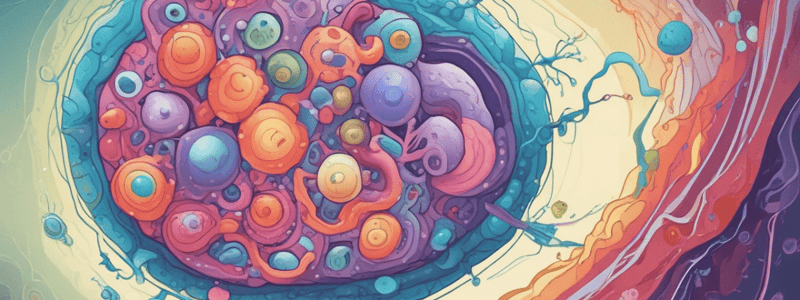Podcast
Questions and Answers
What is unique about the cell membrane of eukaryotic cells compared to prokaryotic cells?
What is unique about the cell membrane of eukaryotic cells compared to prokaryotic cells?
- They are double-layered
- They contain sterols (correct)
- They contain peptidoglycan
- They are semi-permeable
How do prokaryotic cells, such as bacteria, replicate?
How do prokaryotic cells, such as bacteria, replicate?
- By budding
- By binary fission (correct)
- By mitosis
- By meiosis
What determines the shape of a bacterium?
What determines the shape of a bacterium?
- Its cytoplasmic membrane
- Its nucleoid
- Its cell wall (correct)
- Its cytoplasm
How do certain cocci arrange themselves?
How do certain cocci arrange themselves?
What is the term for bacteria that are variable in shape?
What is the term for bacteria that are variable in shape?
What is the primary function of the nucleoid in a prokaryotic cell?
What is the primary function of the nucleoid in a prokaryotic cell?
Which of the following is a characteristic of prokaryotic DNA?
Which of the following is a characteristic of prokaryotic DNA?
What is the function of pili (fimbriae) in bacteria?
What is the function of pili (fimbriae) in bacteria?
What is the purpose of antibiotics that target prokaryotic ribosomes?
What is the purpose of antibiotics that target prokaryotic ribosomes?
What is the role of capsular polysaccharides in vaccine development?
What is the role of capsular polysaccharides in vaccine development?
What is the approximate concentration of bacteria per milliliter required to see one bacterium per microscopic field using the oil immersion lens?
What is the approximate concentration of bacteria per milliliter required to see one bacterium per microscopic field using the oil immersion lens?
What is the function of teichoic acids in gram-positive bacteria?
What is the function of teichoic acids in gram-positive bacteria?
What is the location of the peptidoglycan layer in gram-negative bacteria?
What is the location of the peptidoglycan layer in gram-negative bacteria?
What are the components of ribosomes in prokaryotic cells?
What are the components of ribosomes in prokaryotic cells?
What is the region of the cytoplasm that contains DNA in prokaryotic cells?
What is the region of the cytoplasm that contains DNA in prokaryotic cells?
Flashcards are hidden until you start studying
Study Notes
Cell Membrane and Replication
- Eukaryotic cell membranes contain sterols, whereas prokaryotes (except Mycoplasma) do not.
- Prokaryotic cells replicate by binary fission, while eukaryotic cells replicate by mitosis.
Structure of Bacterial Cells
Shape and Size
- Bacteria are classified by shape into three basic groups: cocci, bacilli, and spirochetes.
- Some bacteria are variable in shape and are said to be pleomorphic (many-shaped).
- The shape of a bacterium is determined by its rigid cell wall.
Arrangement of Bacteria
- Certain cocci occur in pairs (diplococci), some in chains (streptococci), and others in grapelike clusters (staphylococci).
- These arrangements are determined by the orientation and degree of attachment of the bacteria at the time of cell division.
Gram Stain
- It takes approximately 100,000 bacteria/mL to see 1 bacterium per microscopic field using the oil immersion (100×) lens.
- The sensitivity of the Gram stain procedure is low.
Medically Important Bacteria That Cannot Be Seen in the Gram Stain
- Meningococcemia is an exception, where high concentrations of Neisseria meningitidis can occur in the blood.
Special Components of Gram-Positive Cell Wall
- Teichoic acids are found in Gram-positive bacteria and can induce septic shock.
- Teichoic acids mediate the attachment of staphylococci to mucosal cells.
- Gram-negative bacteria do not have teichoic acids.
Periplasmic Space
- The periplasmic space is the area between the inner and outer membranes.
- It contains the peptidoglycan layer and a gel-like solution of proteins.
Cytoplasmic Membrane
- The cytoplasmic membrane is a lipid bilayer with selective permeability.
- It is the site of ATP production.
Cytoplasm
- The cytoplasm has two distinct areas: an amorphous matrix and an inner, nucleoid region composed of DNA.
- The cytoplasm contains ribosomes, nutrient granules, metabolites, and plasmids.
Structures Inside Cytoplasm
- Ribosomes consist of rRNA and protein.
- Protein synthesis occurs at ribosomes and can be inhibited by certain antibiotics.
- Prokaryotic ribosomes (70s) are different from eukaryotic ribosomes (80s), allowing antibiotics to selectively target prokaryotic ribosomes.
Nucleoid
- The nucleoid is the area of the cytoplasm where DNA is located.
- Bacterial DNA is a single, circular molecule that contains about 2000 genes.
- Bacterial DNA has no introns, unlike eukaryotic DNA.
Plasmids
- Plasmids are extrachromosomal, double-stranded, circular DNA molecules that can replicate independently of the bacterial chromosome.
- Plasmids carry genes for antibiotic resistance, heavy metal resistance, UV light resistance, pili, and exotoxins.
Structures Outside the Cell
- Capsule is a gelatinous layer covering the entire bacterium, composed of polysaccharide.
- Capsule is a determinant of virulence, limits phagocytosis, and is used in specific organism identification and vaccine production.
Studying That Suits You
Use AI to generate personalized quizzes and flashcards to suit your learning preferences.




